New Brunswick, a maritime province in eastern Canada located on the Atlantic coast, is a birdwatcher’s paradise. The region is home to a wide array of the native and migratory species of birds, including the bright and cheerful yellow birds.
These birds are a favorite among birdwatchers and novice enthusiasts alike, with their striking yellow feathers and pleasing songs.
In this article, we will explore the various types of yellow birds that can be spotted in New Brunswick, giving birdwatchers a guide to seek out these beautiful creatures in their natural surroundings.
So, let’s delve into the world of the yellow birds of New Brunswick and discover their fascinating characteristics.
1. American Goldfinch
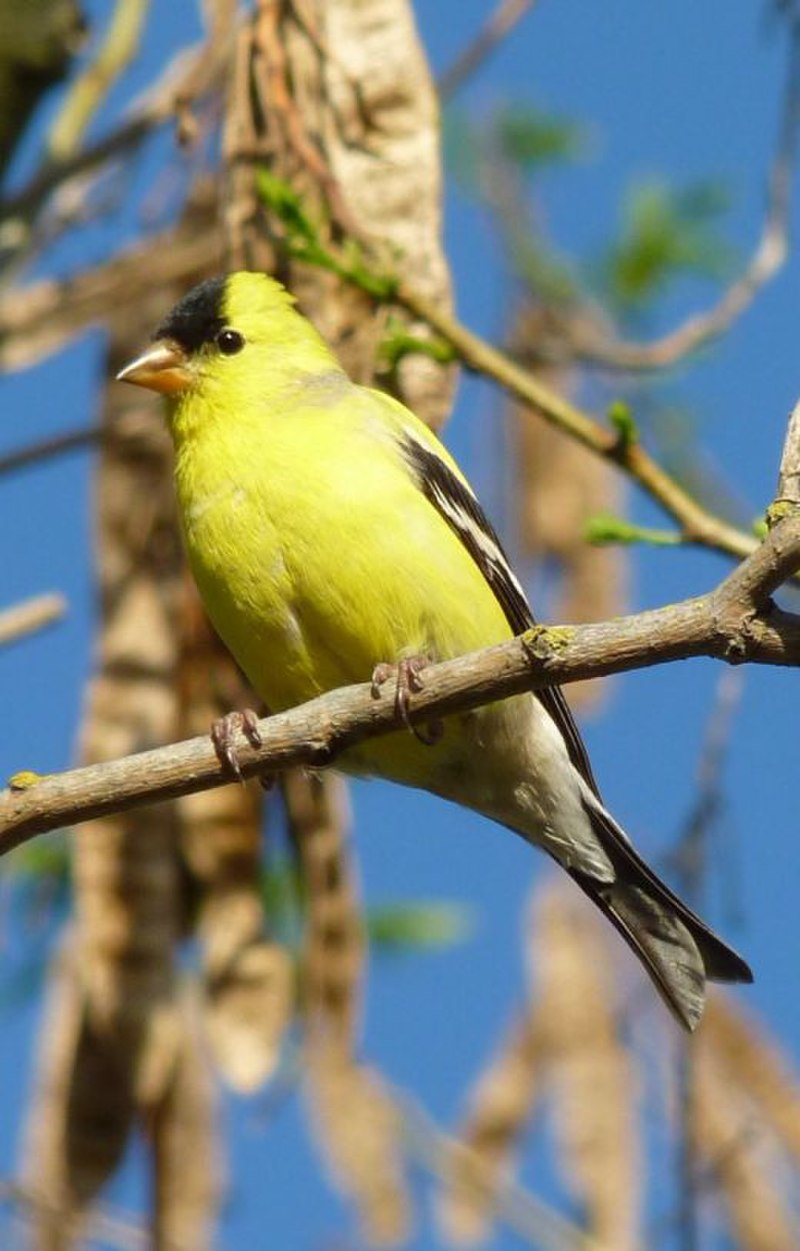
The American goldfinch is a small North American bird in the finch family. Males are vibrant yellow with black wings and tail, while females are duller in colouration.
It migrates from mid-Alberta to North Carolina during breeding season, south of Canada–United States border to Mexico for its wintering grounds.
The only finch which undergoes complete molt every year, it displays sexual dichromatism where males have brighter colours than their female counterparts.
They feed mainly on seeds but also eat insects such as aphids and caterpillars when raising youngs; they often occur near thistles or other plants that produce viable seed heads.
Their call consists of an array of chirps and trills making them quite conspicuous.Scientific classification:
| Kingdom | Animalia |
| Phylum | Chordata |
| Class | Aves |
| Order | Passeriformes |
| Family | Fringillidae |
| Subfamily | Carduelinae |
| Genus | Spinus |
| Species | S. tristis |
Also Featured In: Most Common United States Birds, Blue Birds You’ll Found around Us
2. Yellow-Rumped Warbler
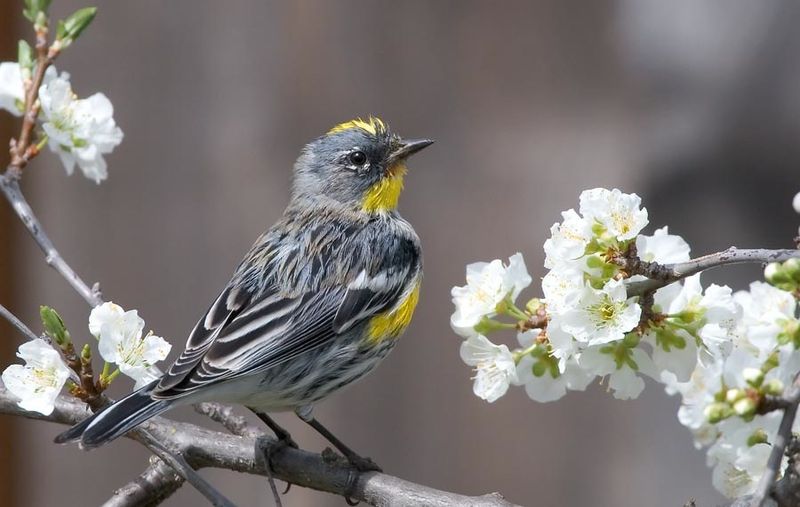
The Yellow-rumped Warbler (Setophaga coronata) is a migratory bird species that can be found throughout North America.
It has an extensive range, from the Pacific and Atlantic coats of the US to Canada and Central America, with a concentration in northern areas during breeding season.
These birds migrate southwards for wintering grounds where they find plentiful food sources such as insects and berries.
They are easily identified by their yellow patches on either side of their tails, along with white underparts, gray back feathers and two distinct crown stripes.
One black or greyish-brown above the eyes extending towards its neck banded in yellow or light brown colouration.
Furthermore, these warblers have strong legs which allow them to cling onto branches while hunting for prey making them adept at maneuvering through tree cover quickly.
All together this makes the Yellow-rumped Warbler an attractive backyard visitor year round.Scientific classification:
| Kingdom | Animalia |
| Phylum | Chordata |
| Class | Aves |
| Order | Passeriformes |
| Family | Parulidae |
| Genus | Setophaga |
| Species | S. coronata |
Also Featured In: Most Popular Bird Species in North America, Birds Live Near San Diego
3. Canada Warbler
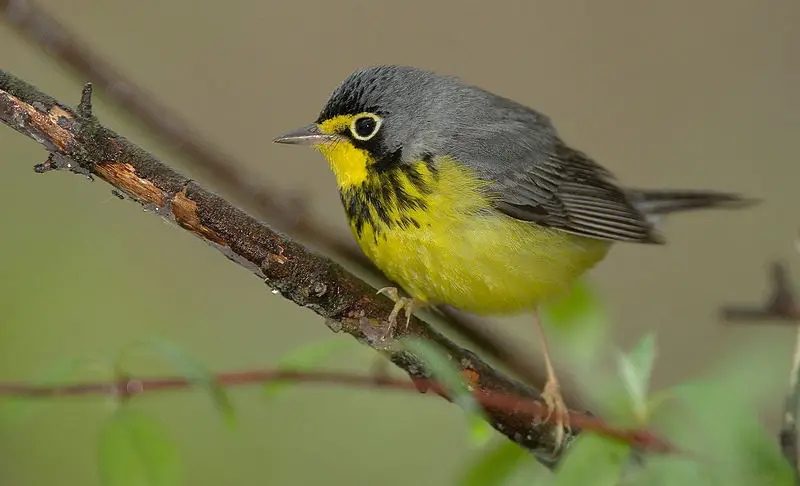
The Canada warbler is a small songbird of the Parulidae family, native to North America. It has olive-green upper parts with yellow underparts and white wing bars, making it easily identifiable.
During summer months they are found in Canada and northeastern United States while during winter their range extends to northern South America.
Mathurin Jacques Brisson was the first to describe this species in 1760 after he collected a specimen from Canada; which resulted in its French name Le gobe-mouche du Canada (Canada’s flycatcher).
Its diet consists mainly of insects such as beetles and mosquitoes, but also includes berries occassionally.
With an estimated population of 5 million individuals they remain common across much of their range although numbers have been declining due to habitat loss caused by human development activities like logging or agricultural expansion.Scientific classification:
| Kingdom | Animalia |
| Phylum | Chordata |
| Class | Aves |
| Order | Passeriformes |
| Family | Parulidae |
| Genus | Cardellina |
| Species | C. canadensis |
Also Featured In: Common Birds in Canada, Common Northwest Territories Birds
4. White-Throated Sparrow
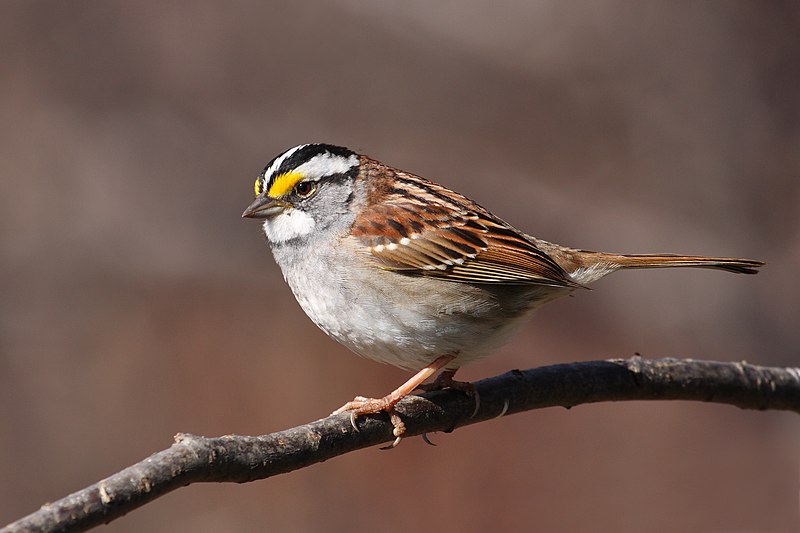
The White-throated Sparrow is a small passerine bird of the New World sparrow family Passerellidae.
It has distinctive yellow and black stripes on its head, white throat and chest with grey back and wings, along with light brown legs.
The scientific name “Zonotrichia albicollis” comes from Ancient Greek for ‘band’ (ζώνη) referring to its distinctive striped crown, and Latin for ‘white neck’ (albus collum).
These birds are usually found in wooded areas such as coniferous forests or deciduous habitats in North America where they feed mainly on insects during summer months; transitioning to seeds during winter.
They build their nests near ground level using grasses, twigs or moss lined with feathers.
White-throated Sparrows may be solitary but also form flocks when migrating southward each fall season which typically occurs over mid-late October through November depending on location within range.Scientific classification:
| Kingdom | Animalia |
| Phylum | Chordata |
| Class | Aves |
| Order | Passeriformes |
| Family | Passerellidae |
| Genus | Zonotrichia |
| Species | Z. albicollis |
Also Featured In: Birds that Migrate through Illinois in the Spring, Birds of Taiga
5. Cape May Warbler
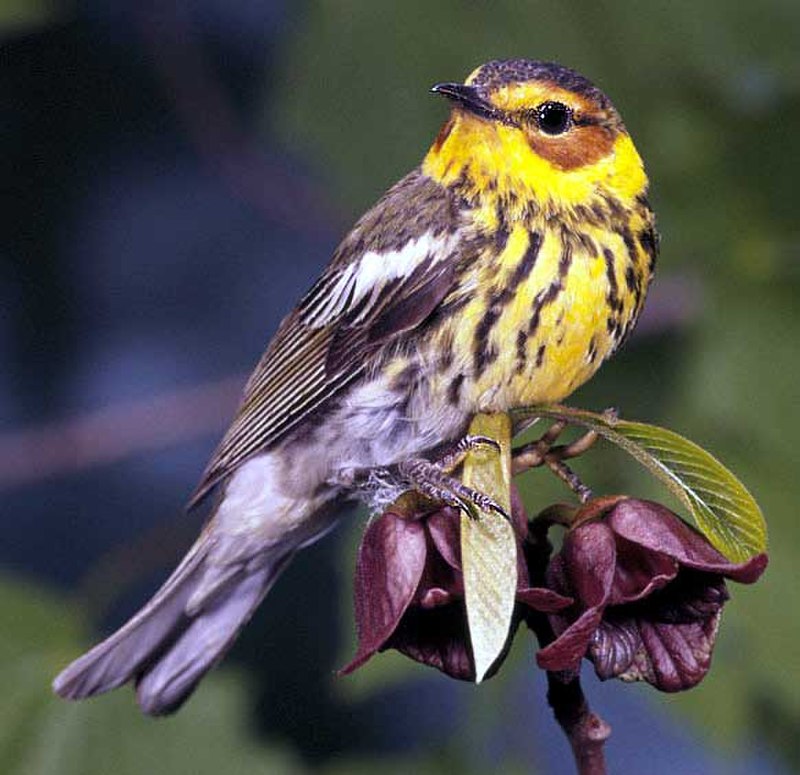
The Cape May Warbler is a species of New World warbler that breeds in northern North America, ranging from southern Canada to the Great Lakes region and New England.
During wintertime it migrates to the West Indies. This bird is an uncommon vagrant to western Europe with two records so far in Britain as of 2013.
It gets its name from being first discovered near Cape May, New Jersey back in 1811 by Alexander Wilson who noted its yellow breast plumage and black streaking on his specimen’s sides.
The males are more brightly colored than females but both sexes have white eye rings which help distinguish them among other warblers during migration season.
They mainly feed on insects and can often be seen foraging at high levels up amongst trees or shrubs where they tend their nests containing 3-5 eggs each breeding season between April – June.Scientific classification:
| Kingdom | Animalia |
| Phylum | Chordata |
| Class | Aves |
| Order | Passeriformes |
| Family | Parulidae |
| Genus | Setophaga |
| Species | S. tigrina |
Also Featured In: Birds of Haiti, Adirondack Mountain Birds
6. Pine Warbler
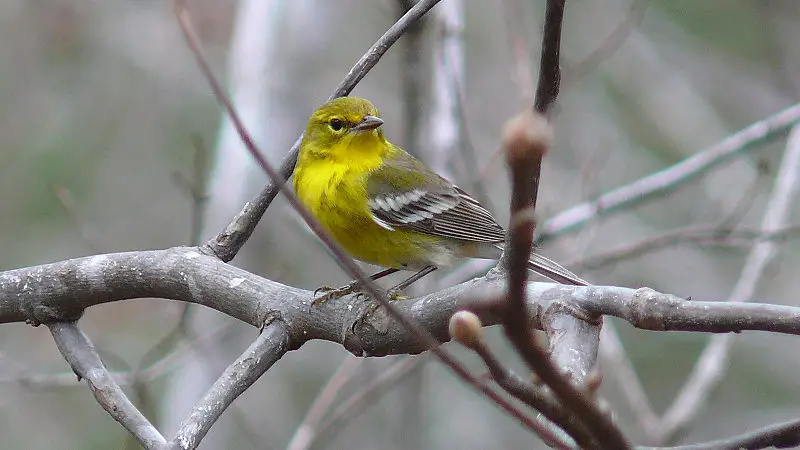
The Pine Warbler is a small bird from the New World warbler family, with an olive-brown upperparts and white belly.
Its distinguishing features include two white wing bars, dark legs, thin pointed bills and yellowish ‘spectacles’ around its eyes.
Adult males have bright yellow throats and breasts on top of their olive upperparts; females and immatures are less vibrant in colour but retain similar characteristics.
These birds can be found near pine forests throughout North America during summer months before migrating to warmer climates for winter.
They feed mainly on insects such as caterpillars, spiders and flies while also consuming fruits like blueberries when food becomes scarce in colder times of year.
All in all, these tiny songbirds provide us with much beauty through their unique plumage patterns whilst serving important roles within their ecosystems.Scientific classification:
| Kingdom | Animalia |
| Phylum | Chordata |
| Class | Aves |
| Order | Passeriformes |
| Family | Parulidae |
| Genus | Setophaga |
| Species | S. pinus |
Also Featured In: Most Common Types of Birds Found in Cuba, Common Yellow Birds of Idaho
7. Scarlet Tanager
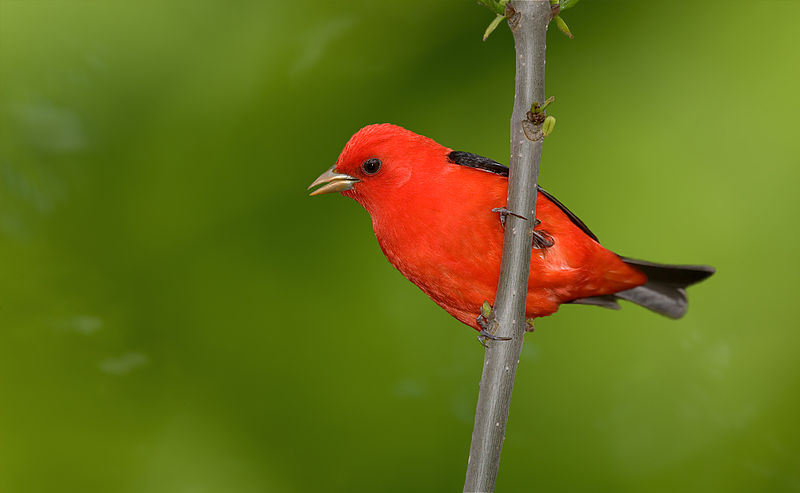
The Scarlet Tanager is a beautiful medium-sized bird found in parts of North and South America. It belongs to the Cardinal family, and has striking red plumage with black wings and tail feathers.
Its song is similar to other cardinals yet also unique in its own way – it’s recognizable by its high whistles that become lower towards the end.
The species feeds mainly on insects as well as berries from trees or shrubs during breeding season, when they may form loose flocks over open woodlands foraging for food.
They are highly territorial birds during nesting season which happens between April and June each year; both males and females fiercely defend their nests against intruders such as cats or squirrels.Scientific classification:
| Kingdom | Animalia |
| Phylum | Chordata |
| Class | Aves |
| Order | Passeriformes |
| Family | Cardinalidae |
| Genus | Piranga |
| Species | P. olivacea |
Also Featured In: Georgia Birds, Red birds You’ll See in Arizona
8. Evening Grosbeak
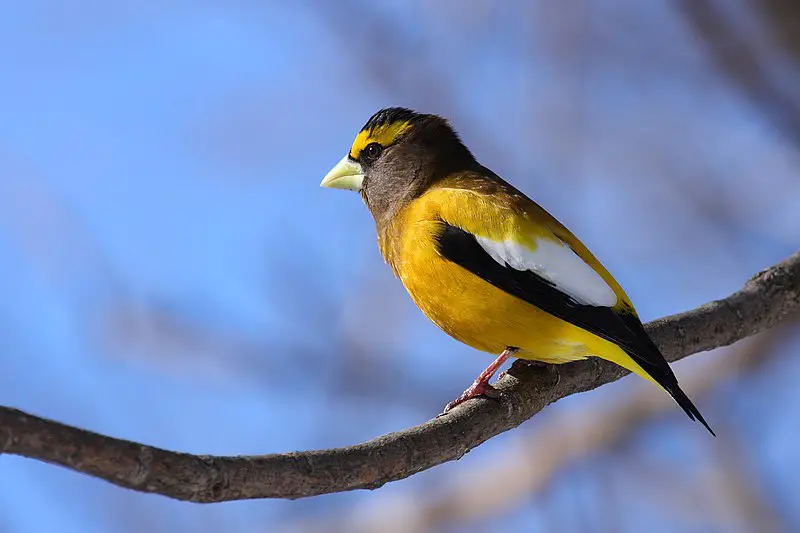
The Evening Grosbeak (Hesperiphona vespertina) is a beautiful passerine bird in the finch family Fringillidae native to North America.
It has an impressive wingspan of up to 20 inches and its plumage is mostly black, yellow or grey with distinctive white patches on each side of its head.
Its diet consists mainly of seeds and other plant matter as well as small insects, fruit and berries when available.
The male’s song is loud and melodic which can be heard from some distance away during breeding season making it a popular species for avid backyard birders.
The Evening Grosbeak typically nests high in coniferous trees where they build cup-shaped structures lined with feathers or grass that provide protection against predators.
Overall this species makes an excellent addition to any backyard aviary.Scientific classification:
| Kingdom | Animalia |
| Phylum | Chordata |
| Class | Aves |
| Order | Passeriformes |
| Family | Fringillidae |
| Subfamily | Carduelinae |
| Genus | Hesperiphona |
| Species | H. vespertina |
Also Featured In: Finches Species, Most Common Winter Birds
9. Orange-Crowned Warbler
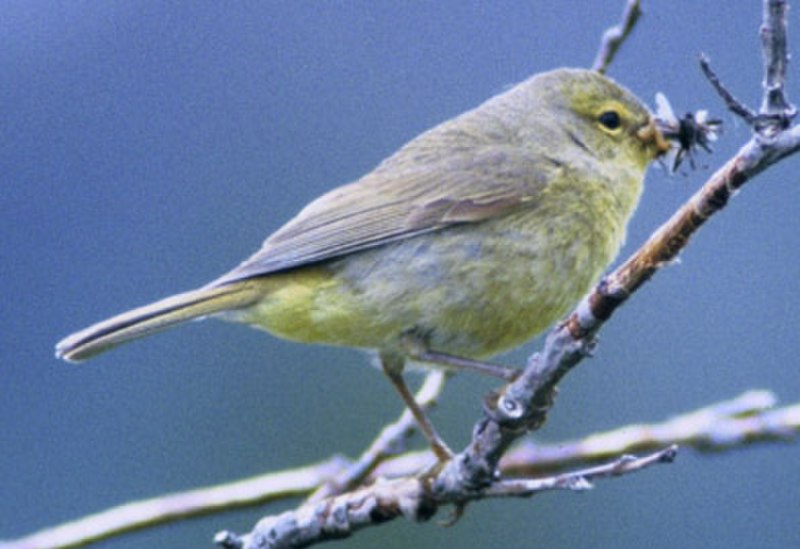
The Orange-crowned Warbler is a small songbird from the New World warbler family. It was formally described in 1822 by Thomas Say, who gave it its scientific name Sylvia celatus – Latin for ‘cloaked’.
This species has an olive green back and wings with yellowish underparts. The males have bright orange crowns during breeding season, which give this bird its namesake.
They can be found mainly in North America but they also migrate to Central America during winter months.
Their diet consists of insects such as butterflies, moths, grasshoppers and beetles; they may also consume fruits occasionally when available.
These birds are relatively quiet except for their mating calls which include whistles or buzzing sounds that last a few seconds long each time.
The Orange-crowned Warbler is one of the most wide spread passerines today due to their hardiness and adaptability; however there remains threat of habitat destruction that could affect many populations negatively if not addressed soon enough.Scientific classification:
| Kingdom | Animalia |
| Phylum | Chordata |
| Class | Aves |
| Order | Passeriformes |
| Family | Parulidae |
| Genus | Leiothlypis |
| Species | L. celata |
Also Featured In: Texas Birds, Phoenix Birds You Should Know
10. American Yellow Warbler
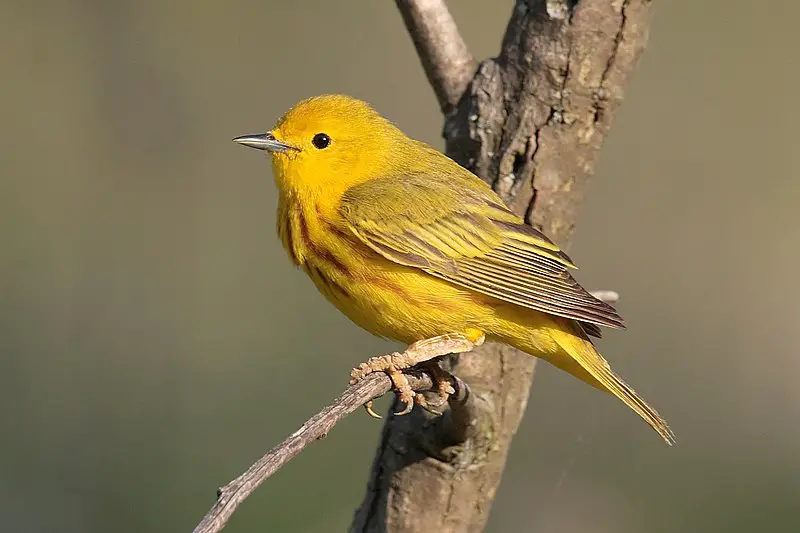
The American Yellow Warbler (Setophaga petechia) is a species of New World warbler found across North America, the Caribbean and into northern South America.
Its genus name Setophaga comes from Ancient Greek words meaning “moth” and “eating”, while its specific name Petechia originates from Italian for small red spots.
This bird has striking yellow plumage with reddish-brown streaks on their chest that can be seen during mating season when they are most colourful.
They live in open woodlands near wetlands or bodies of water where they can find food such as insects like spiders, beetles and caterpillars which make up much of their diet.
The male will sing to attract a mate during breeding season before setting up home in twig nests built by both sexes together high in trees or shrubs.Scientific classification:
| Kingdom | Animalia |
| Phylum | Chordata |
| Class | Aves |
| Order | Passeriformes |
| Family | Parulidae |
| Genus | Setophaga |
| Species | S. petechia |
Also Featured In: Utah Birds, Most Common Songs Birds that Live around You
11. Common Yellowthroat
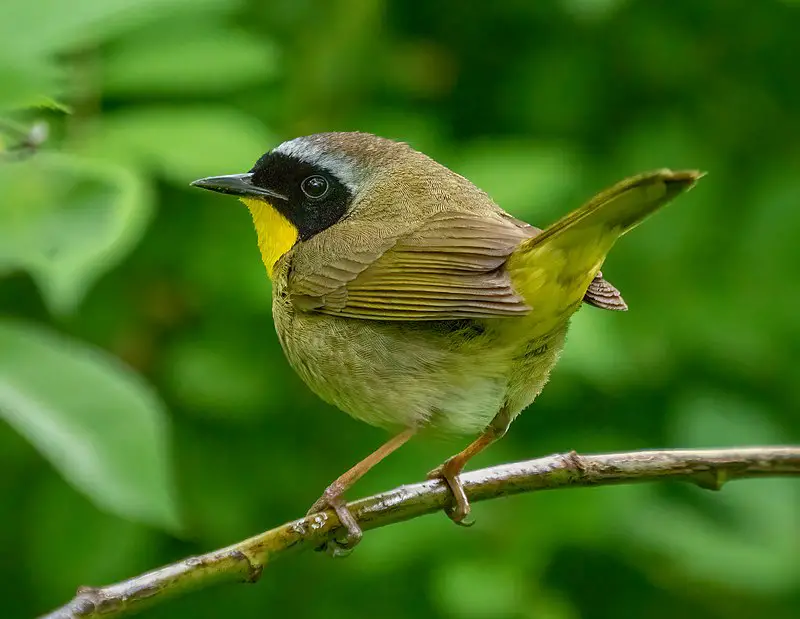
The Common Yellowthroat is a small, New World Warbler found throughout North America. It has distinctive yellow and black plumage that earned it the nickname “Yellow Bandit” in the Midwest United States.
This species is highly adaptable and can be found inhabiting wetlands, grasslands, shrub-land habitats, as well as suburban areas.
The genus of this bird’s scientific name translates to mean ‘ground’ and ‘small bird’, which are fitting characteristics for such an elusive yet common little creature.
Its diet consists predominantly of insects but may also include other invertebrates like spiders or worms.
Overall the Common Yellowthroat makes an excellent addition to any backyard with its cheerful song.Scientific classification:
| Kingdom | Animalia |
| Phylum | Chordata |
| Class | Aves |
| Order | Passeriformes |
| Family | Parulidae |
| Genus | Geothlypis |
| Species | G. trichas |
Also Featured In: Nebraska Birds, Birds Commonly Found in New York
12. Wilson’s Warbler
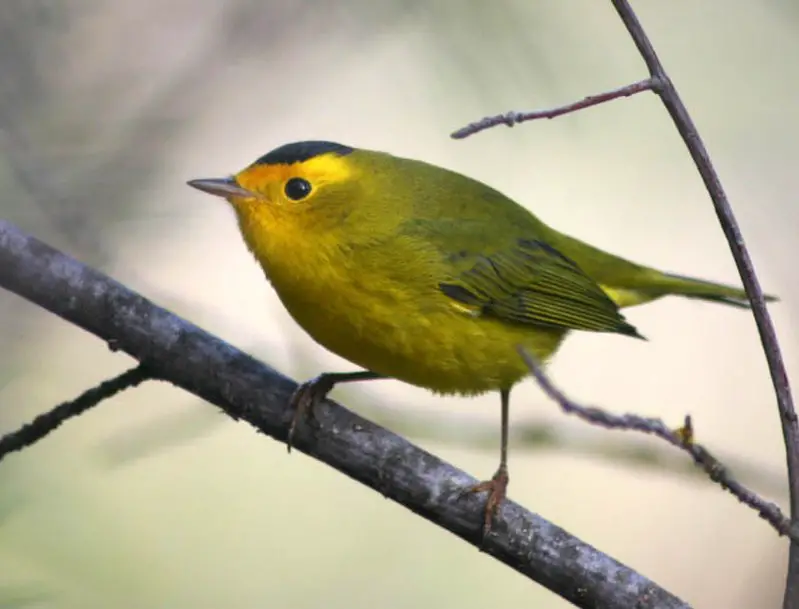
Wilson’s warbler is a small, brightly coloured bird found across North America. It has greenish upperparts and yellow underparts, with rounded wings and a long tail.
The male has an easily identifiable black crown patch which may or may not be present in the female depending on the subspecies.
They breed from Canada down to central parts of Mexico and then winter south through much of Central America.
These birds are usually seen flitting around low vegetation as they search for insects to eat – their main food source.
Their cheerful song can often be heard during spring migration when they travel back up north to breed again after spending winter further south.Scientific classification:
| Kingdom | Animalia |
| Phylum | Chordata |
| Class | Aves |
| Order | Passeriformes |
| Family | Parulidae |
| Genus | Cardellina |
| Species | C. pusilla |
Also Featured In: Common Birds in Saskatchewan, Birds in Iowa Spring
13. Black-Throated Green Warbler
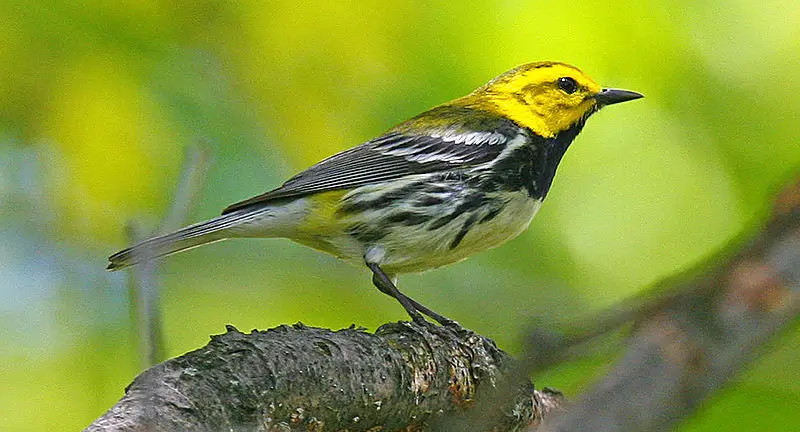
The Black-throated Green Warbler is a beautiful and dainty songbird in the New World warbler family.
It has an olive green crown, yellow face with dark markings, white wing bars and pale underparts streaked with black on the sides.
Adult males have a striking black throat and upper breast while females show paler coloration on their throats but retain some black patterning across their chest area.
They are quite small birds measuring around 14 cm in length from bill to tail tip that make them easy to miss if they aren’t singing.
Their diet consists mainly of insects which they catch by flitting through trees or shrubs as well as foraging among foliage making this species great help in controlling bug populations.Scientific classification:
| Kingdom | Animalia |
| Phylum | Chordata |
| Class | Aves |
| Order | Passeriformes |
| Family | Parulidae |
| Genus | Setophaga |
| Species | S. virens |
Also Featured In: Maine Birds, Birds of Nova Scotia
14. Nashville Warbler
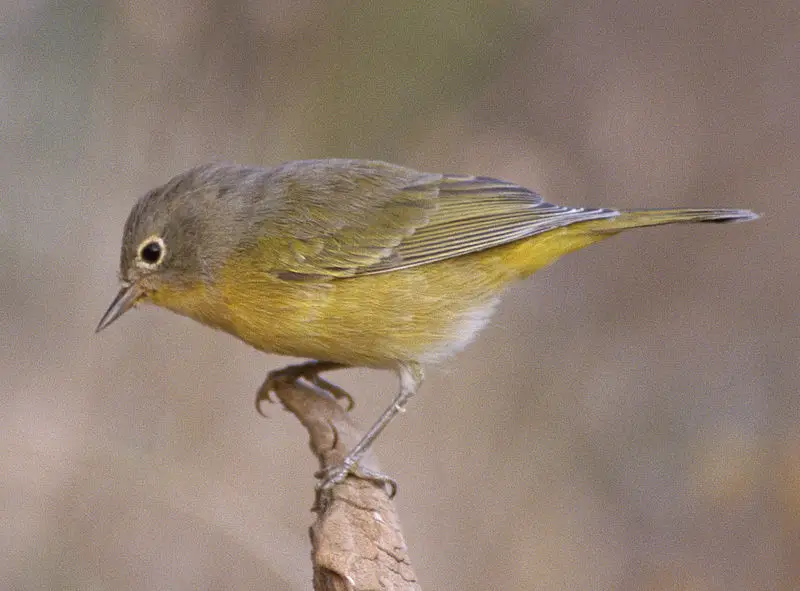
The Nashville Warbler is a small bird found in North and Central America. It has gray head, green back and yellowish-white underparts.
During breeding season it can be seen in parts of the northern and western United States, southern Canada as well as Mexico; while during winter it migrates to places like California, Texas or further south into Central America.
Its diet consists mainly of insects which they find by foraging on trees or shrubs near open woodlands with dense vegetation.
They are fairly active birds that move around often when searching for food, making them easy to spot if you know where to look.Scientific classification:
| Kingdom | Animalia |
| Phylum | Chordata |
| Class | Aves |
| Order | Passeriformes |
| Family | Parulidae |
| Genus | Leiothlypis |
| Species | L. ruficapilla |
Also Featured In: birds of Kansas, New Hampshire Birds You Should Know
15. Palm Warbler
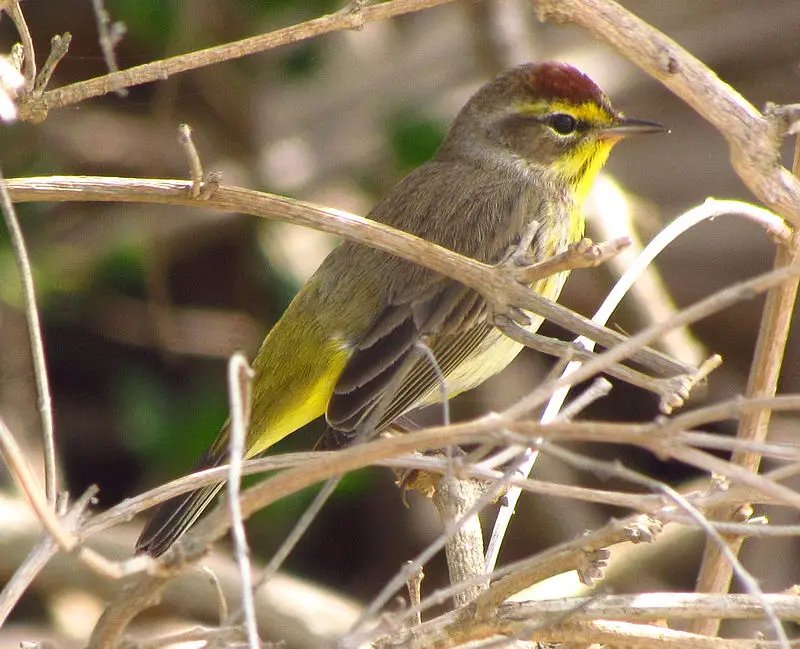
The palm warbler is a small songbird found in the New World, belonging to the warbler family.
It has two distinct subspecies that differ mainly in their plumage – eastern palm warblers have yellower underparts and bolder rufous streaks on their breast and flanks than western ones.
These birds are light olive above with whitish bellies and yellow throats.
They also have distinctive white-tipped tail feathers which they often flick while foraging or singing during breeding season, when males establish territories through song duels.
The diet of these birds consists mostly of insects such as beetles, moths, ants and caterpillars collected from trees or ground vegetation like grasses or sedges.
Palm Warblers migrate long distances between its wintering grounds near Central America to northeastern North American states where it breeds each summer before returning south again come fall.Scientific classification:
| Kingdom | Animalia |
| Phylum | Chordata |
| Class | Aves |
| Order | Passeriformes |
| Family | Parulidae |
| Genus | Setophaga |
| Species | S. palmarum |
Also Featured In: birds of Rhode Island, Autumn Birds You Should Know
16. American Redstart
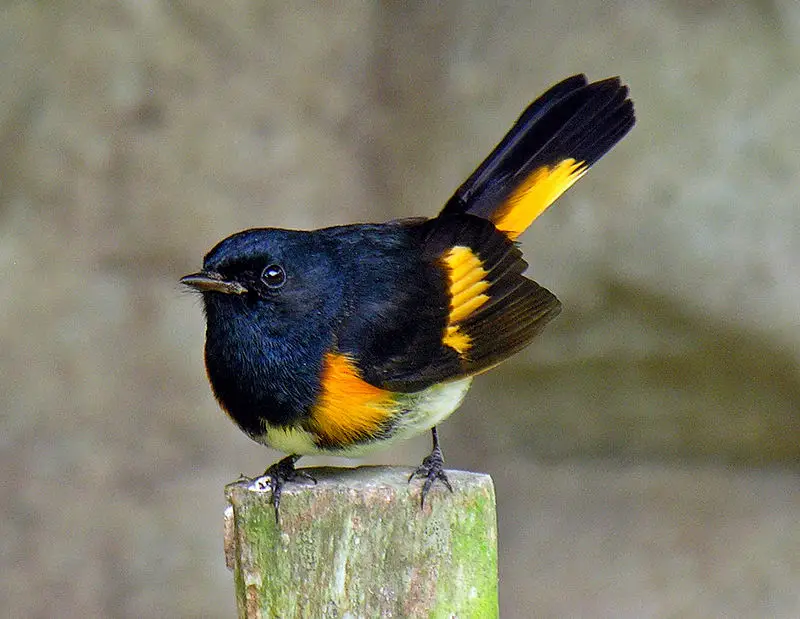
The American Redstart is a beautiful New World Warbler, first documented by Carl Linnaeus in 1758.
It has an elegant black and orange plumage that sets it apart from other birds.
The genus name Setophaga comes from the Ancient Greek words ‘sēs’ meaning moth and ‘phagos’, which means eating – referencing its insect-eating habits.
Its song is one of joy, with short repeating phrases making up their melodic tune.
They are mostly found hopping around trees on their long legs during breeding season but migrate to Central America for winter months when food sources become scarce in North America.Scientific classification:
| Kingdom | Animalia |
| Phylum | Chordata |
| Class | Aves |
| Order | Passeriformes |
| Family | Parulidae |
| Genus | Setophaga |
| Species | S. ruticilla |
Also Featured In: birds of Vermont, Birds that Live in Mississippi
17. Magnolia Warbler
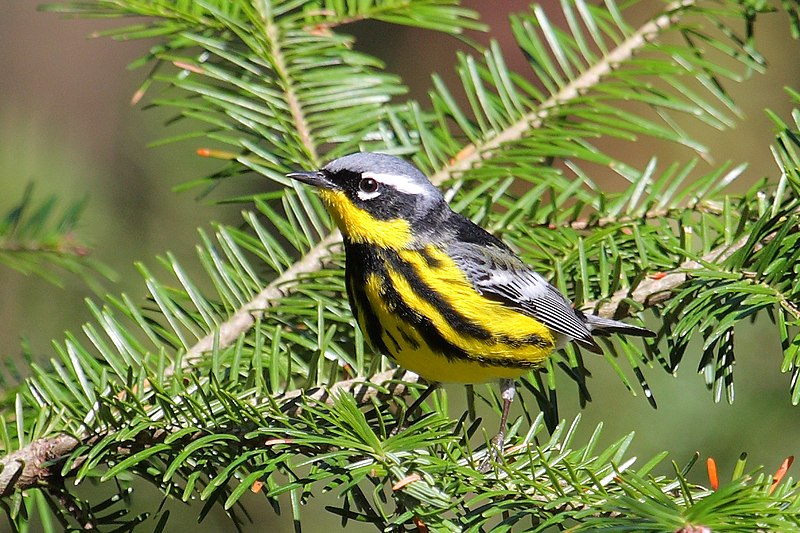
The Magnolia Warbler is a small and beautiful bird native to North America. It belongs to the wood warbler family of Parulidae and its name derives from type locality Fort Adams, Mississippi where it was first discovered by Alexander Wilson.
This species has an overall length ranging between 4 – 5 inches with wingspan measuring up to 6-7 inches long.
Its plumage consists of yellow chest which turns into olive green on top while its underside takes white hue and throat remains black in coloration along with two white wingbars present on either sides.
In terms of diet, they feed mainly on insects like caterpillars, moths etc., but also feeds upon fruits or seeds occasionally during winter season as well as migratory period too.Scientific classification:
| Kingdom | Animalia |
| Phylum | Chordata |
| Class | Aves |
| Order | Passeriformes |
| Family | Parulidae |
| Genus | Setophaga |
| Species | S. magnolia |
Also Featured In: birds of yellow birds, Yellow Connecticut Birds
18. Northern Flicker
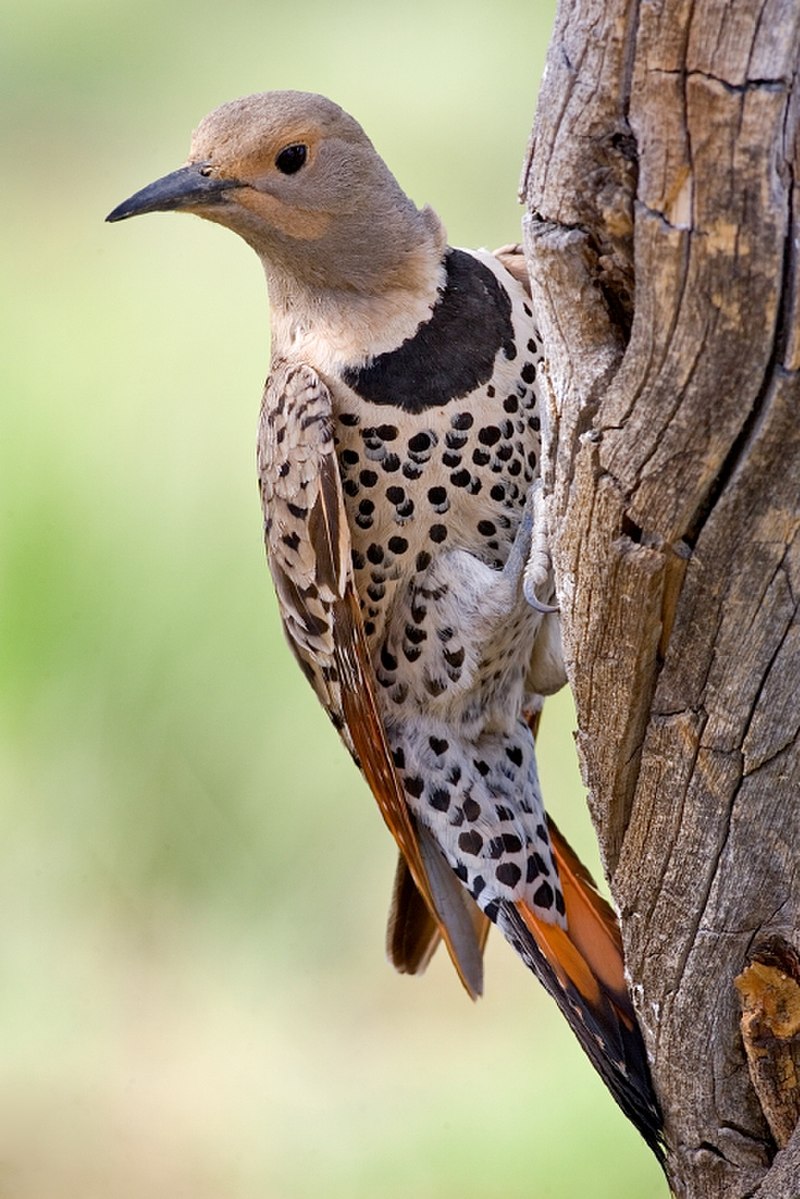
The Northern flicker is a woodpecker species found in North America, Central America, Cuba, and the Cayman Islands. This medium-sized bird is known for its unique migration behavior.
Over 100 common names are used to refer to the Northern flicker, one of them being “yellowhammer”. It is a beautiful bird with distinctive markings and a colorful plumage.
The Northern flicker is an important species in its ecosystem and plays a key role in maintaining a healthy balance in the environment.
Despite being a woodpecker, the Northern flicker has a diverse diet that includes insects, fruits, and seeds.
It is fascinating to observe this bird as it pecks at trees in search of food, communicates with its unique vocalizations and performs its incredible aerial displays.
The Northern flicker is truly a remarkable bird species that is worthy of our admiration and protection.Scientific classification:
| Kingdom | Animalia |
| Phylum | Chordata |
| Class | Aves |
| Order | Piciformes |
| Family | Picidae |
| Genus | Colaptes |
| Species | C. auratus |
Also Featured In: Birds That Live in Colorado, Birds Live in Arkansas
19. Cedar Waxwing
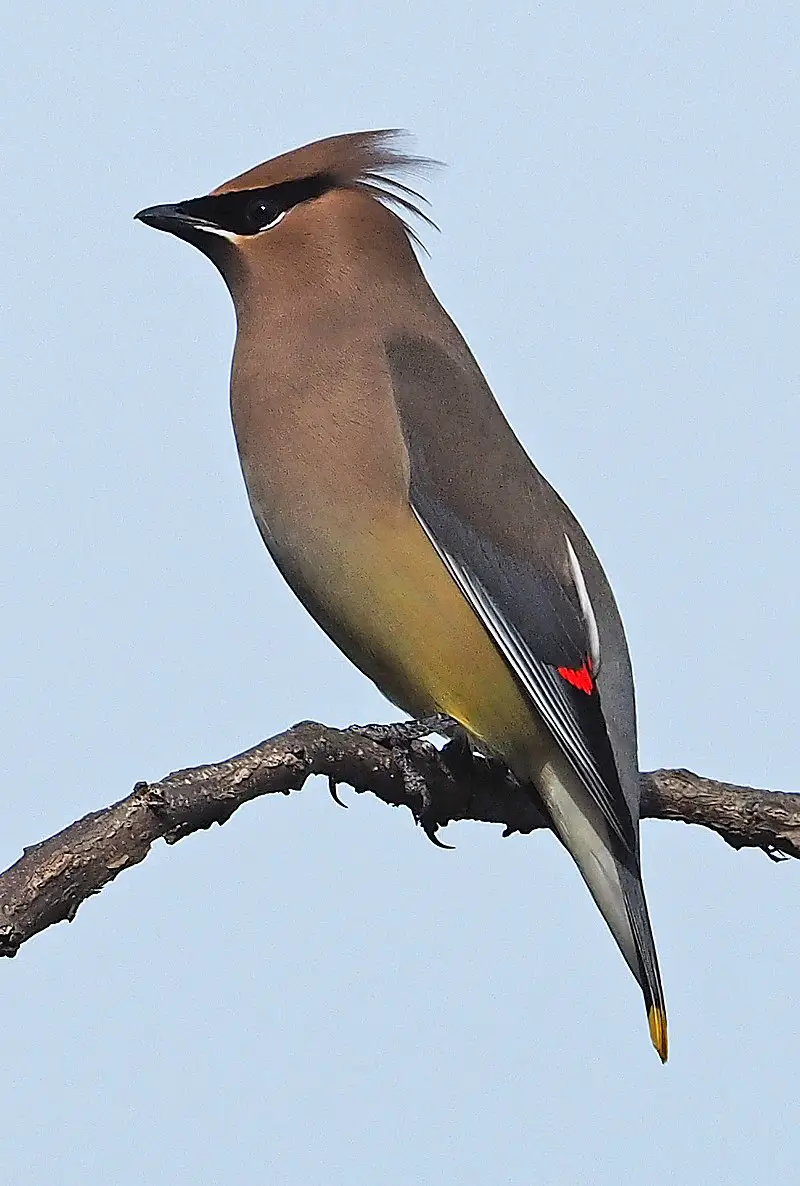
The Cedar waxwing, also known as Bombycilla cedrorum, is a medium-sized bird found in North and Central America.
They have a mixture of brown, gray and yellow feathers on their body, and their wings have wax-like tips.
These birds prefer open wooded areas in Southern Canada for breeding, and during winter, they migrate to the Southern part of the United States, Central America, and the far.
The Cedar waxwing is a member of the waxwing family of birds or Bombycillidae family.
They are known for their distinctive crest on their head and a black mask-like area around their eyes.
These birds are social creatures and can often be seen in large flocks, sometimes even intermixing with other bird species.
Their diet consists mainly of fruit and insects, and they are important dispersers of fruit seeds.
The Cedar waxwing bird is a beautiful and fascinating creature to observe in the wild.Scientific classification:
| Kingdom | Animalia |
| Phylum | Chordata |
| Class | Aves |
| Order | Passeriformes |
| Family | Bombycillidae |
| Genus | Bombycilla |
| Species | B. cedrorum |
Also Featured In: Central Texas Birds, Summer Birds that Live around Us